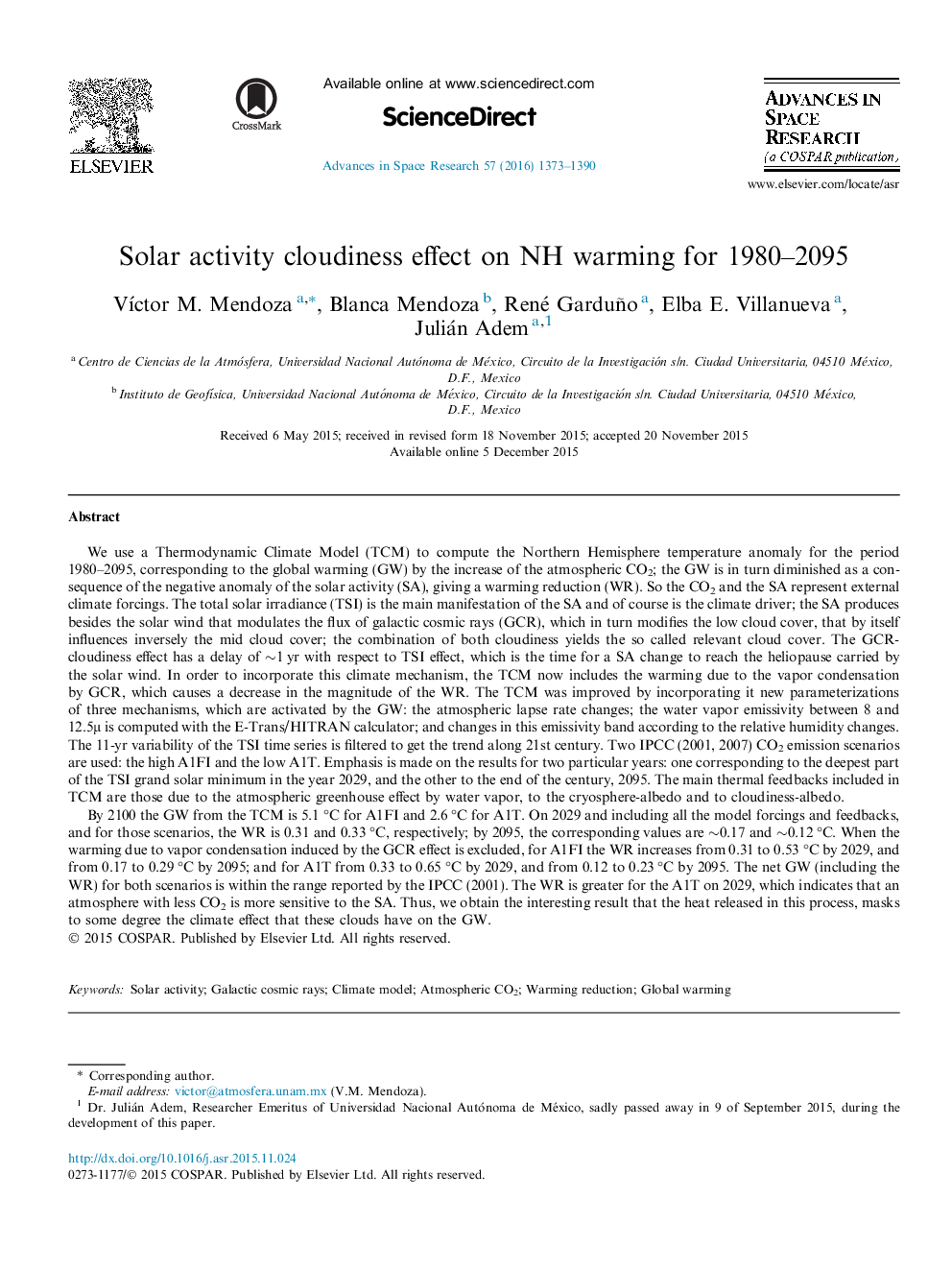| کد مقاله | کد نشریه | سال انتشار | مقاله انگلیسی | نسخه تمام متن |
|---|---|---|---|---|
| 1763677 | 1020017 | 2016 | 18 صفحه PDF | دانلود رایگان |

We use a Thermodynamic Climate Model (TCM) to compute the Northern Hemisphere temperature anomaly for the period 1980–2095, corresponding to the global warming (GW) by the increase of the atmospheric CO2; the GW is in turn diminished as a consequence of the negative anomaly of the solar activity (SA), giving a warming reduction (WR). So the CO2 and the SA represent external climate forcings. The total solar irradiance (TSI) is the main manifestation of the SA and of course is the climate driver; the SA produces besides the solar wind that modulates the flux of galactic cosmic rays (GCR), which in turn modifies the low cloud cover, that by itself influences inversely the mid cloud cover; the combination of both cloudiness yields the so called relevant cloud cover. The GCR-cloudiness effect has a delay of ∼1 yr with respect to TSI effect, which is the time for a SA change to reach the heliopause carried by the solar wind. In order to incorporate this climate mechanism, the TCM now includes the warming due to the vapor condensation by GCR, which causes a decrease in the magnitude of the WR. The TCM was improved by incorporating it new parameterizations of three mechanisms, which are activated by the GW: the atmospheric lapse rate changes; the water vapor emissivity between 8 and 12.5μ is computed with the E-Trans/HITRAN calculator; and changes in this emissivity band according to the relative humidity changes. The 11-yr variability of the TSI time series is filtered to get the trend along 21st century. Two IPCC (2001, 2007) CO2 emission scenarios are used: the high A1FI and the low A1T. Emphasis is made on the results for two particular years: one corresponding to the deepest part of the TSI grand solar minimum in the year 2029, and the other to the end of the century, 2095. The main thermal feedbacks included in TCM are those due to the atmospheric greenhouse effect by water vapor, to the cryosphere-albedo and to cloudiness-albedo.By 2100 the GW from the TCM is 5.1 °C for A1FI and 2.6 °C for A1T. On 2029 and including all the model forcings and feedbacks, and for those scenarios, the WR is 0.31 and 0.33 °C, respectively; by 2095, the corresponding values are ∼0.17 and ∼0.12 °C. When the warming due to vapor condensation induced by the GCR effect is excluded, for A1FI the WR increases from 0.31 to 0.53 °C by 2029, and from 0.17 to 0.29 °C by 2095; and for A1T from 0.33 to 0.65 °C by 2029, and from 0.12 to 0.23 °C by 2095. The net GW (including the WR) for both scenarios is within the range reported by the IPCC (2001). The WR is greater for the A1T on 2029, which indicates that an atmosphere with less CO2 is more sensitive to the SA. Thus, we obtain the interesting result that the heat released in this process, masks to some degree the climate effect that these clouds have on the GW.
Journal: Advances in Space Research - Volume 57, Issue 6, 15 March 2016, Pages 1373–1390